Swinburne University: DDD70014 Eco-Design Project - Solar Powered Cart
VerifiedAdded on 2022/09/18
|7
|1263
|31
Project
AI Summary
This project presents the design of a solar-powered cart intended for use in Lamu, Kenya, addressing sustainable development goals (SDGs). The student focuses on the need for sustainable transport solutions, particularly for the movement of goods and people. The design incorporates solar panels to power the cart, promoting renewable energy and reducing greenhouse gas emissions, aligning with SDG 13 (Climate Action). The cart's design considers the local context, including the use of donkeys and handcarts. The project details the cart's functionality, structural specifications, and material choices (metal, steel, and iron), and includes design drawings created using AutoCAD and Inventor Autodesk. The project's conclusion emphasizes the potential of the solar-powered cart to improve living standards, address local challenges like water supply and trade, and activate the New Urban Agenda, thereby contributing to multiple SDGs. References are included, such as Eliakim (2010) and Kazungu (2019).
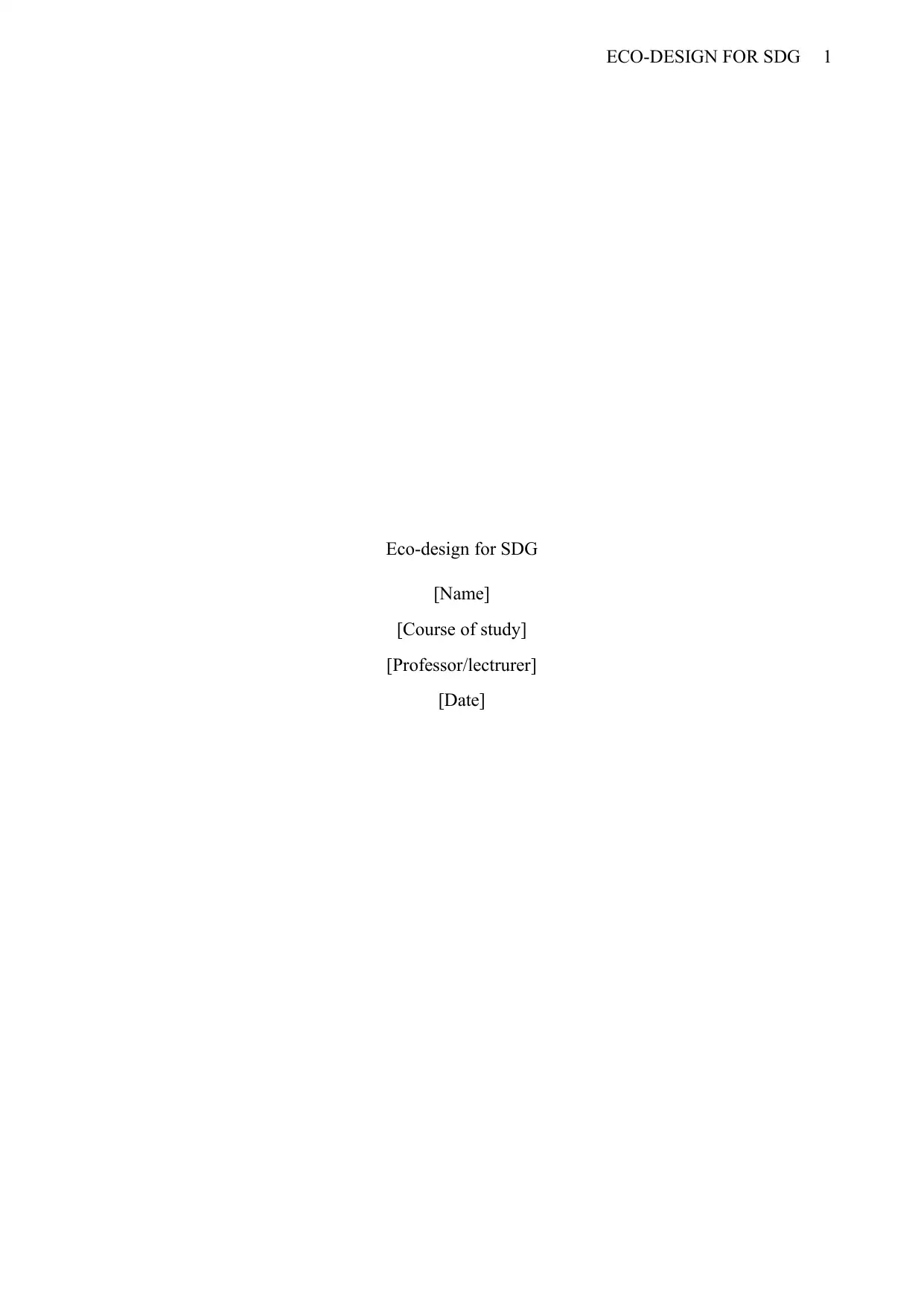
1ECO-DESIGN FOR SDG
Eco-design for SDG
[Name]
[Course of study]
[Professor/lectrurer]
[Date]
Eco-design for SDG
[Name]
[Course of study]
[Professor/lectrurer]
[Date]
Paraphrase This Document
Need a fresh take? Get an instant paraphrase of this document with our AI Paraphraser
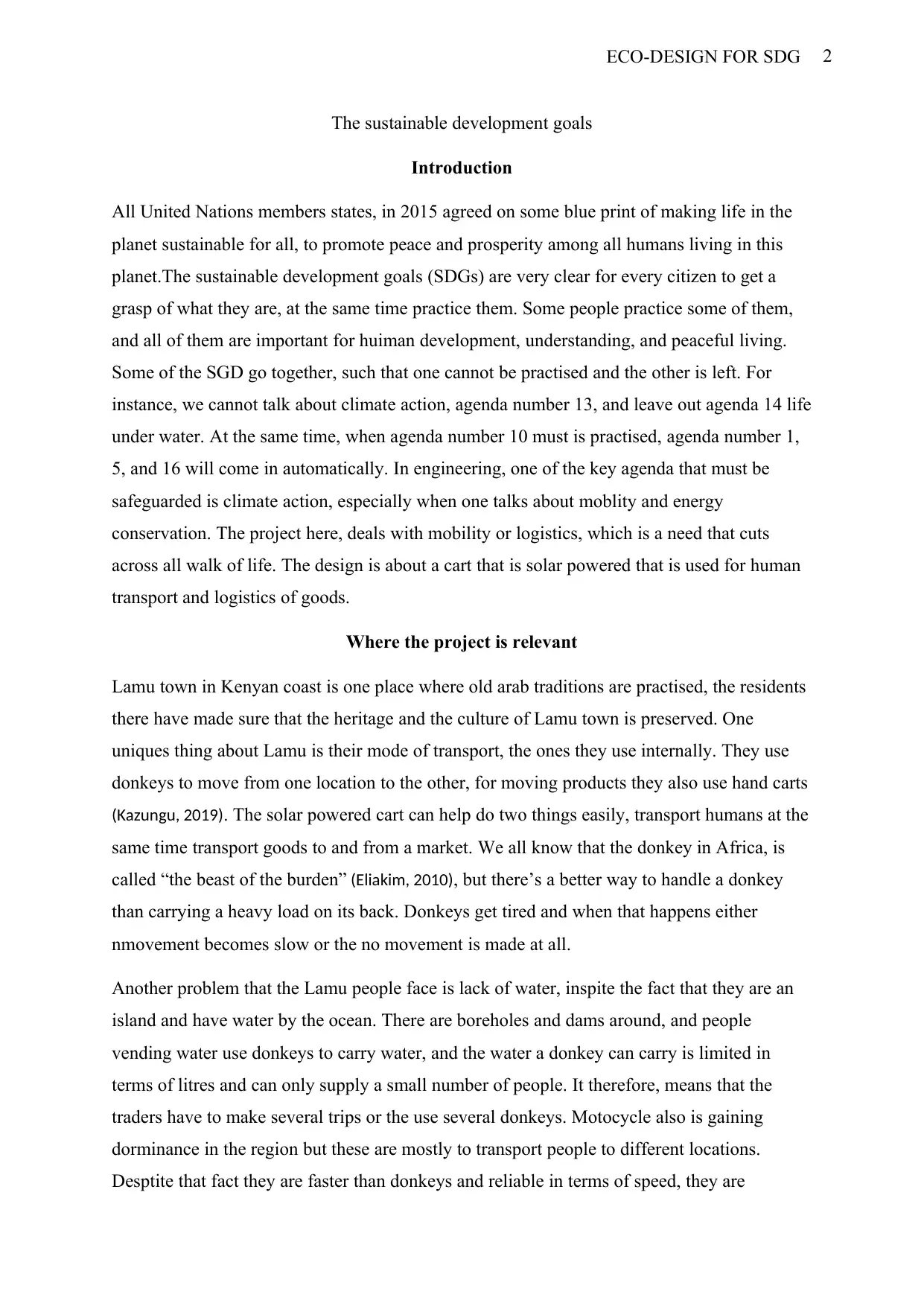
2ECO-DESIGN FOR SDG
The sustainable development goals
Introduction
All United Nations members states, in 2015 agreed on some blue print of making life in the
planet sustainable for all, to promote peace and prosperity among all humans living in this
planet.The sustainable development goals (SDGs) are very clear for every citizen to get a
grasp of what they are, at the same time practice them. Some people practice some of them,
and all of them are important for huiman development, understanding, and peaceful living.
Some of the SGD go together, such that one cannot be practised and the other is left. For
instance, we cannot talk about climate action, agenda number 13, and leave out agenda 14 life
under water. At the same time, when agenda number 10 must is practised, agenda number 1,
5, and 16 will come in automatically. In engineering, one of the key agenda that must be
safeguarded is climate action, especially when one talks about moblity and energy
conservation. The project here, deals with mobility or logistics, which is a need that cuts
across all walk of life. The design is about a cart that is solar powered that is used for human
transport and logistics of goods.
Where the project is relevant
Lamu town in Kenyan coast is one place where old arab traditions are practised, the residents
there have made sure that the heritage and the culture of Lamu town is preserved. One
uniques thing about Lamu is their mode of transport, the ones they use internally. They use
donkeys to move from one location to the other, for moving products they also use hand carts
(Kazungu, 2019). The solar powered cart can help do two things easily, transport humans at the
same time transport goods to and from a market. We all know that the donkey in Africa, is
called “the beast of the burden” (Eliakim, 2010), but there’s a better way to handle a donkey
than carrying a heavy load on its back. Donkeys get tired and when that happens either
nmovement becomes slow or the no movement is made at all.
Another problem that the Lamu people face is lack of water, inspite the fact that they are an
island and have water by the ocean. There are boreholes and dams around, and people
vending water use donkeys to carry water, and the water a donkey can carry is limited in
terms of litres and can only supply a small number of people. It therefore, means that the
traders have to make several trips or the use several donkeys. Motocycle also is gaining
dorminance in the region but these are mostly to transport people to different locations.
Desptite that fact they are faster than donkeys and reliable in terms of speed, they are
The sustainable development goals
Introduction
All United Nations members states, in 2015 agreed on some blue print of making life in the
planet sustainable for all, to promote peace and prosperity among all humans living in this
planet.The sustainable development goals (SDGs) are very clear for every citizen to get a
grasp of what they are, at the same time practice them. Some people practice some of them,
and all of them are important for huiman development, understanding, and peaceful living.
Some of the SGD go together, such that one cannot be practised and the other is left. For
instance, we cannot talk about climate action, agenda number 13, and leave out agenda 14 life
under water. At the same time, when agenda number 10 must is practised, agenda number 1,
5, and 16 will come in automatically. In engineering, one of the key agenda that must be
safeguarded is climate action, especially when one talks about moblity and energy
conservation. The project here, deals with mobility or logistics, which is a need that cuts
across all walk of life. The design is about a cart that is solar powered that is used for human
transport and logistics of goods.
Where the project is relevant
Lamu town in Kenyan coast is one place where old arab traditions are practised, the residents
there have made sure that the heritage and the culture of Lamu town is preserved. One
uniques thing about Lamu is their mode of transport, the ones they use internally. They use
donkeys to move from one location to the other, for moving products they also use hand carts
(Kazungu, 2019). The solar powered cart can help do two things easily, transport humans at the
same time transport goods to and from a market. We all know that the donkey in Africa, is
called “the beast of the burden” (Eliakim, 2010), but there’s a better way to handle a donkey
than carrying a heavy load on its back. Donkeys get tired and when that happens either
nmovement becomes slow or the no movement is made at all.
Another problem that the Lamu people face is lack of water, inspite the fact that they are an
island and have water by the ocean. There are boreholes and dams around, and people
vending water use donkeys to carry water, and the water a donkey can carry is limited in
terms of litres and can only supply a small number of people. It therefore, means that the
traders have to make several trips or the use several donkeys. Motocycle also is gaining
dorminance in the region but these are mostly to transport people to different locations.
Desptite that fact they are faster than donkeys and reliable in terms of speed, they are
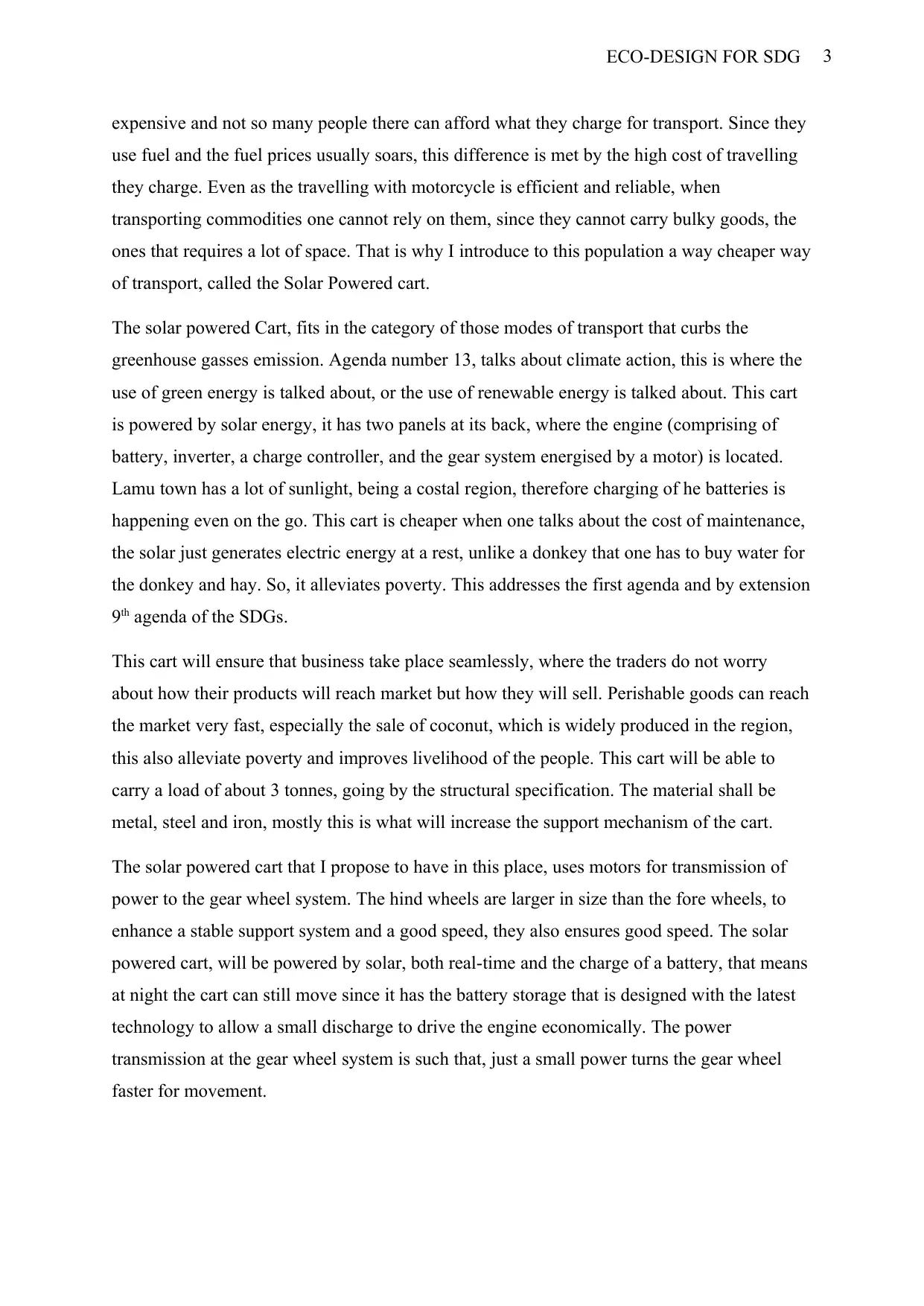
3ECO-DESIGN FOR SDG
expensive and not so many people there can afford what they charge for transport. Since they
use fuel and the fuel prices usually soars, this difference is met by the high cost of travelling
they charge. Even as the travelling with motorcycle is efficient and reliable, when
transporting commodities one cannot rely on them, since they cannot carry bulky goods, the
ones that requires a lot of space. That is why I introduce to this population a way cheaper way
of transport, called the Solar Powered cart.
The solar powered Cart, fits in the category of those modes of transport that curbs the
greenhouse gasses emission. Agenda number 13, talks about climate action, this is where the
use of green energy is talked about, or the use of renewable energy is talked about. This cart
is powered by solar energy, it has two panels at its back, where the engine (comprising of
battery, inverter, a charge controller, and the gear system energised by a motor) is located.
Lamu town has a lot of sunlight, being a costal region, therefore charging of he batteries is
happening even on the go. This cart is cheaper when one talks about the cost of maintenance,
the solar just generates electric energy at a rest, unlike a donkey that one has to buy water for
the donkey and hay. So, it alleviates poverty. This addresses the first agenda and by extension
9th agenda of the SDGs.
This cart will ensure that business take place seamlessly, where the traders do not worry
about how their products will reach market but how they will sell. Perishable goods can reach
the market very fast, especially the sale of coconut, which is widely produced in the region,
this also alleviate poverty and improves livelihood of the people. This cart will be able to
carry a load of about 3 tonnes, going by the structural specification. The material shall be
metal, steel and iron, mostly this is what will increase the support mechanism of the cart.
The solar powered cart that I propose to have in this place, uses motors for transmission of
power to the gear wheel system. The hind wheels are larger in size than the fore wheels, to
enhance a stable support system and a good speed, they also ensures good speed. The solar
powered cart, will be powered by solar, both real-time and the charge of a battery, that means
at night the cart can still move since it has the battery storage that is designed with the latest
technology to allow a small discharge to drive the engine economically. The power
transmission at the gear wheel system is such that, just a small power turns the gear wheel
faster for movement.
expensive and not so many people there can afford what they charge for transport. Since they
use fuel and the fuel prices usually soars, this difference is met by the high cost of travelling
they charge. Even as the travelling with motorcycle is efficient and reliable, when
transporting commodities one cannot rely on them, since they cannot carry bulky goods, the
ones that requires a lot of space. That is why I introduce to this population a way cheaper way
of transport, called the Solar Powered cart.
The solar powered Cart, fits in the category of those modes of transport that curbs the
greenhouse gasses emission. Agenda number 13, talks about climate action, this is where the
use of green energy is talked about, or the use of renewable energy is talked about. This cart
is powered by solar energy, it has two panels at its back, where the engine (comprising of
battery, inverter, a charge controller, and the gear system energised by a motor) is located.
Lamu town has a lot of sunlight, being a costal region, therefore charging of he batteries is
happening even on the go. This cart is cheaper when one talks about the cost of maintenance,
the solar just generates electric energy at a rest, unlike a donkey that one has to buy water for
the donkey and hay. So, it alleviates poverty. This addresses the first agenda and by extension
9th agenda of the SDGs.
This cart will ensure that business take place seamlessly, where the traders do not worry
about how their products will reach market but how they will sell. Perishable goods can reach
the market very fast, especially the sale of coconut, which is widely produced in the region,
this also alleviate poverty and improves livelihood of the people. This cart will be able to
carry a load of about 3 tonnes, going by the structural specification. The material shall be
metal, steel and iron, mostly this is what will increase the support mechanism of the cart.
The solar powered cart that I propose to have in this place, uses motors for transmission of
power to the gear wheel system. The hind wheels are larger in size than the fore wheels, to
enhance a stable support system and a good speed, they also ensures good speed. The solar
powered cart, will be powered by solar, both real-time and the charge of a battery, that means
at night the cart can still move since it has the battery storage that is designed with the latest
technology to allow a small discharge to drive the engine economically. The power
transmission at the gear wheel system is such that, just a small power turns the gear wheel
faster for movement.
⊘ This is a preview!⊘
Do you want full access?
Subscribe today to unlock all pages.

Trusted by 1+ million students worldwide
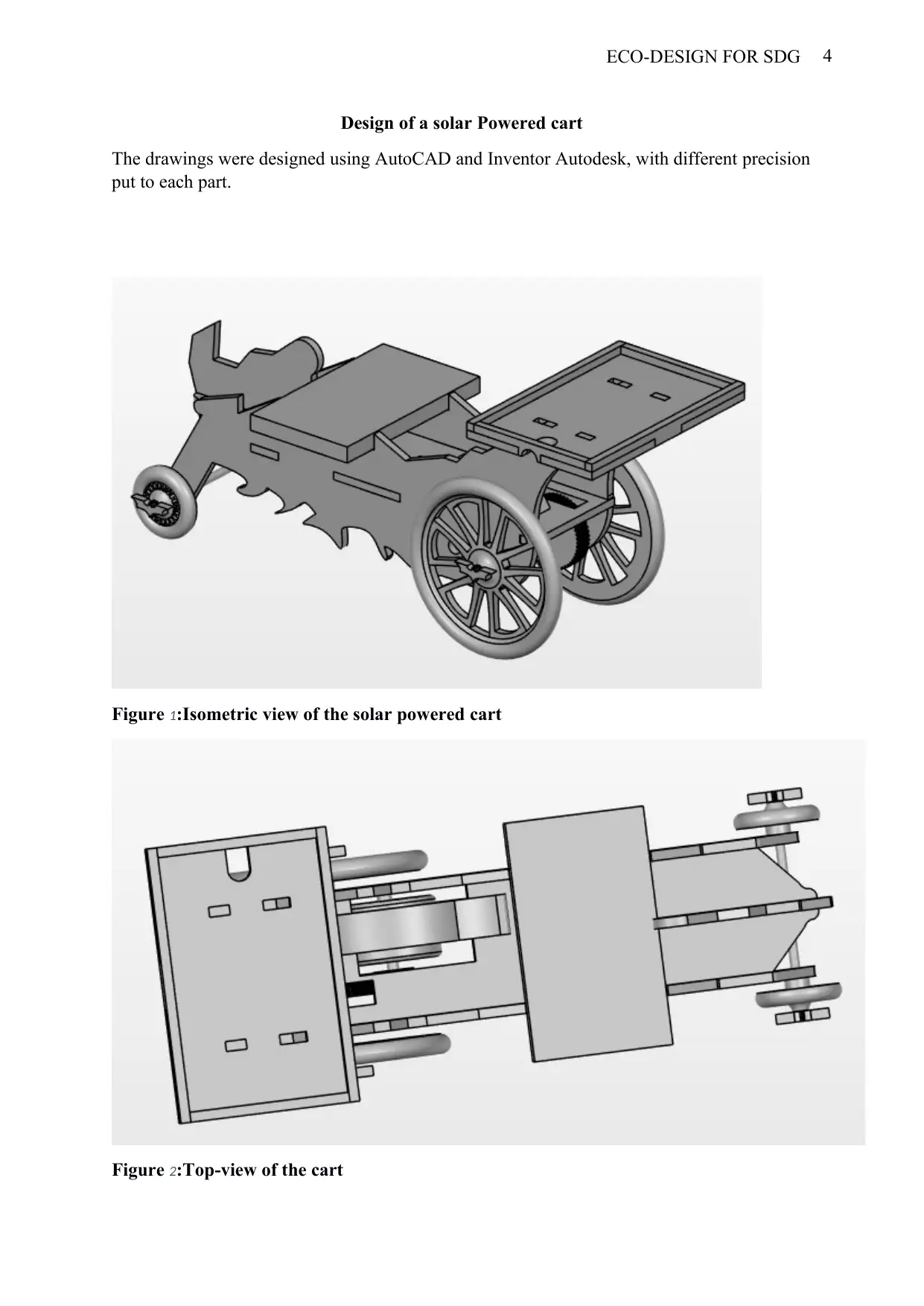
4ECO-DESIGN FOR SDG
Design of a solar Powered cart
The drawings were designed using AutoCAD and Inventor Autodesk, with different precision
put to each part.
Figure 1:Isometric view of the solar powered cart
Figure 2:Top-view of the cart
Design of a solar Powered cart
The drawings were designed using AutoCAD and Inventor Autodesk, with different precision
put to each part.
Figure 1:Isometric view of the solar powered cart
Figure 2:Top-view of the cart
Paraphrase This Document
Need a fresh take? Get an instant paraphrase of this document with our AI Paraphraser
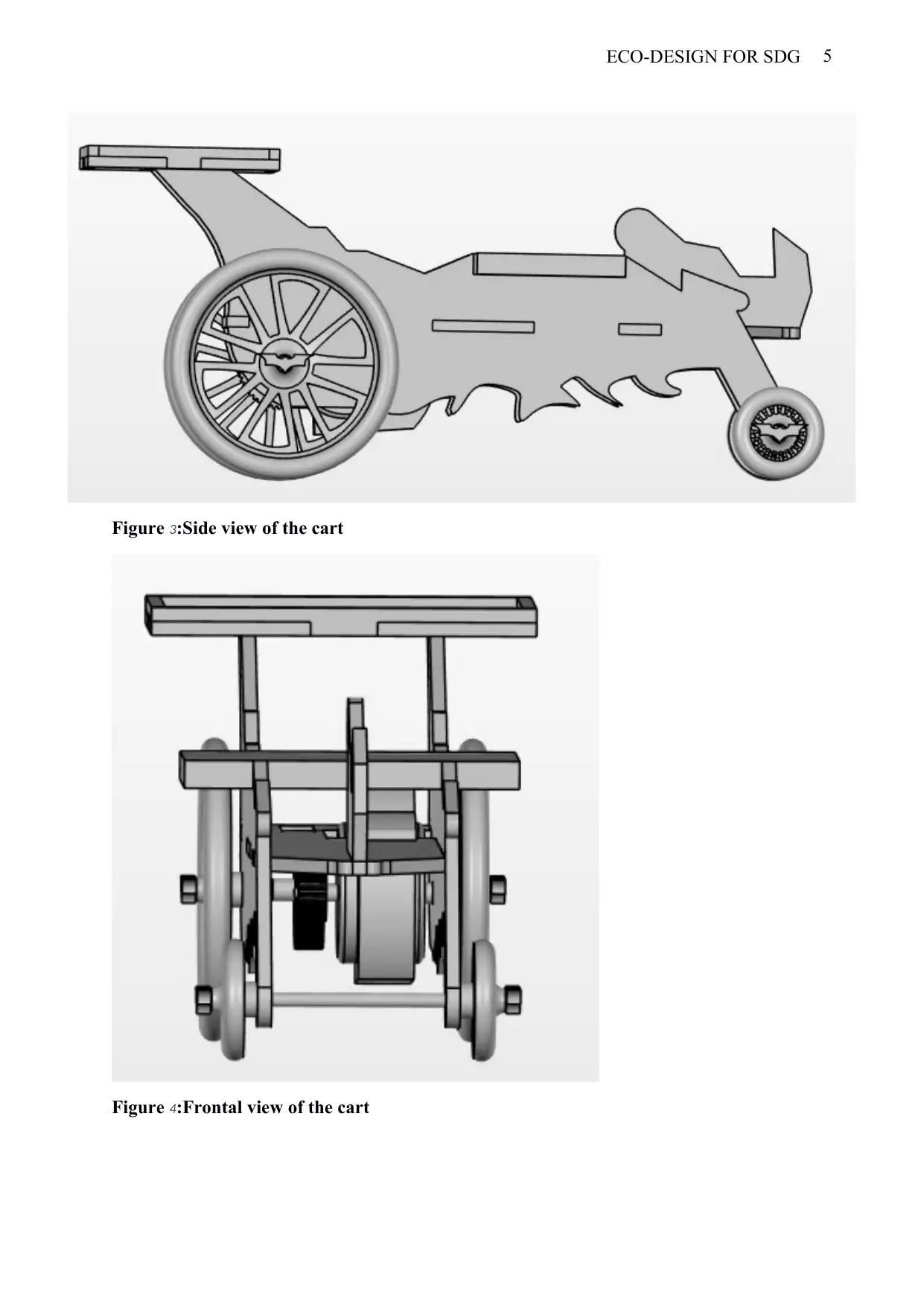
5ECO-DESIGN FOR SDG
Figure 3:Side view of the cart
Figure 4:Frontal view of the cart
Figure 3:Side view of the cart
Figure 4:Frontal view of the cart
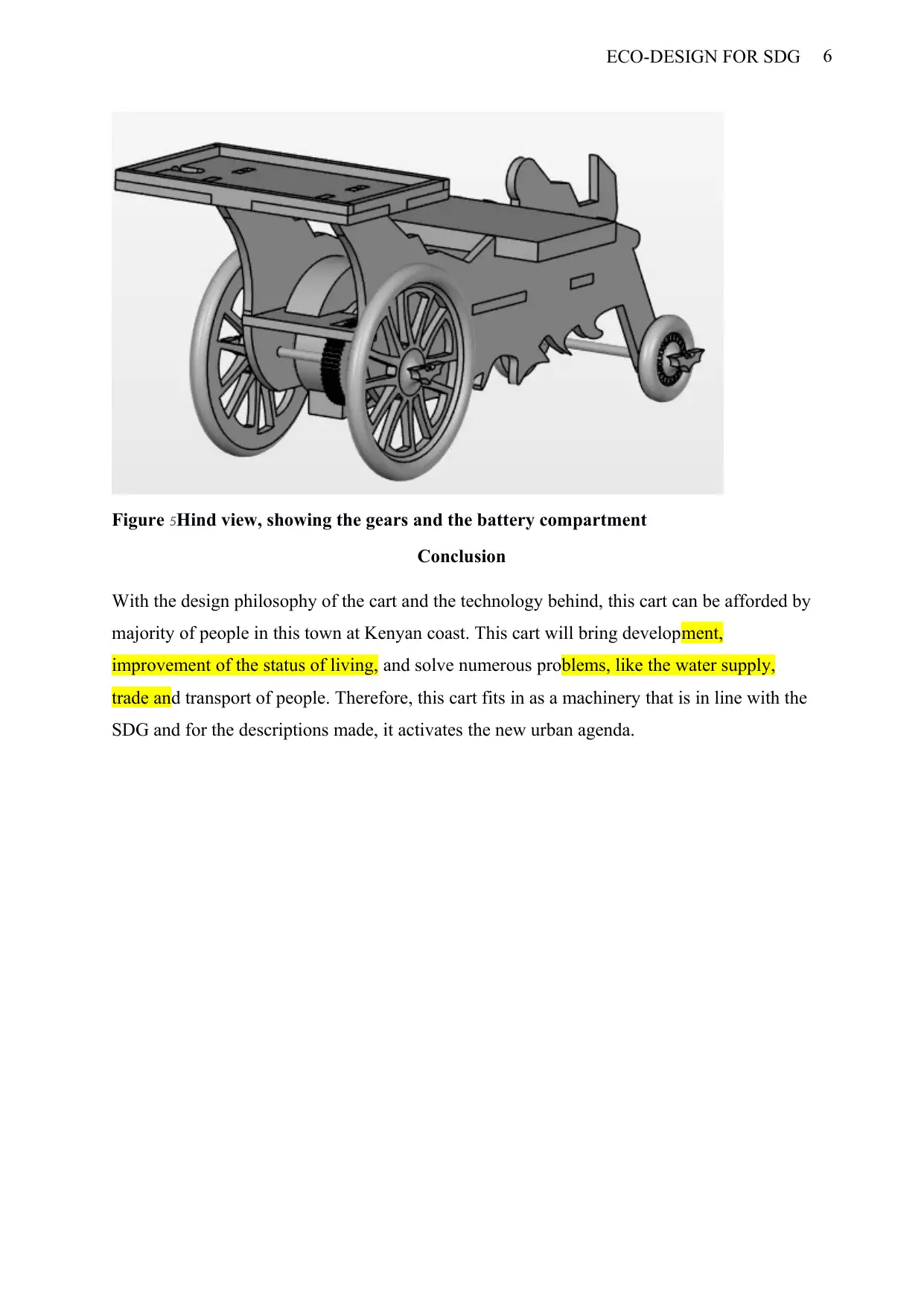
6ECO-DESIGN FOR SDG
Figure 5Hind view, showing the gears and the battery compartment
Conclusion
With the design philosophy of the cart and the technology behind, this cart can be afforded by
majority of people in this town at Kenyan coast. This cart will bring development,
improvement of the status of living, and solve numerous problems, like the water supply,
trade and transport of people. Therefore, this cart fits in as a machinery that is in line with the
SDG and for the descriptions made, it activates the new urban agenda.
Figure 5Hind view, showing the gears and the battery compartment
Conclusion
With the design philosophy of the cart and the technology behind, this cart can be afforded by
majority of people in this town at Kenyan coast. This cart will bring development,
improvement of the status of living, and solve numerous problems, like the water supply,
trade and transport of people. Therefore, this cart fits in as a machinery that is in line with the
SDG and for the descriptions made, it activates the new urban agenda.
⊘ This is a preview!⊘
Do you want full access?
Subscribe today to unlock all pages.

Trusted by 1+ million students worldwide
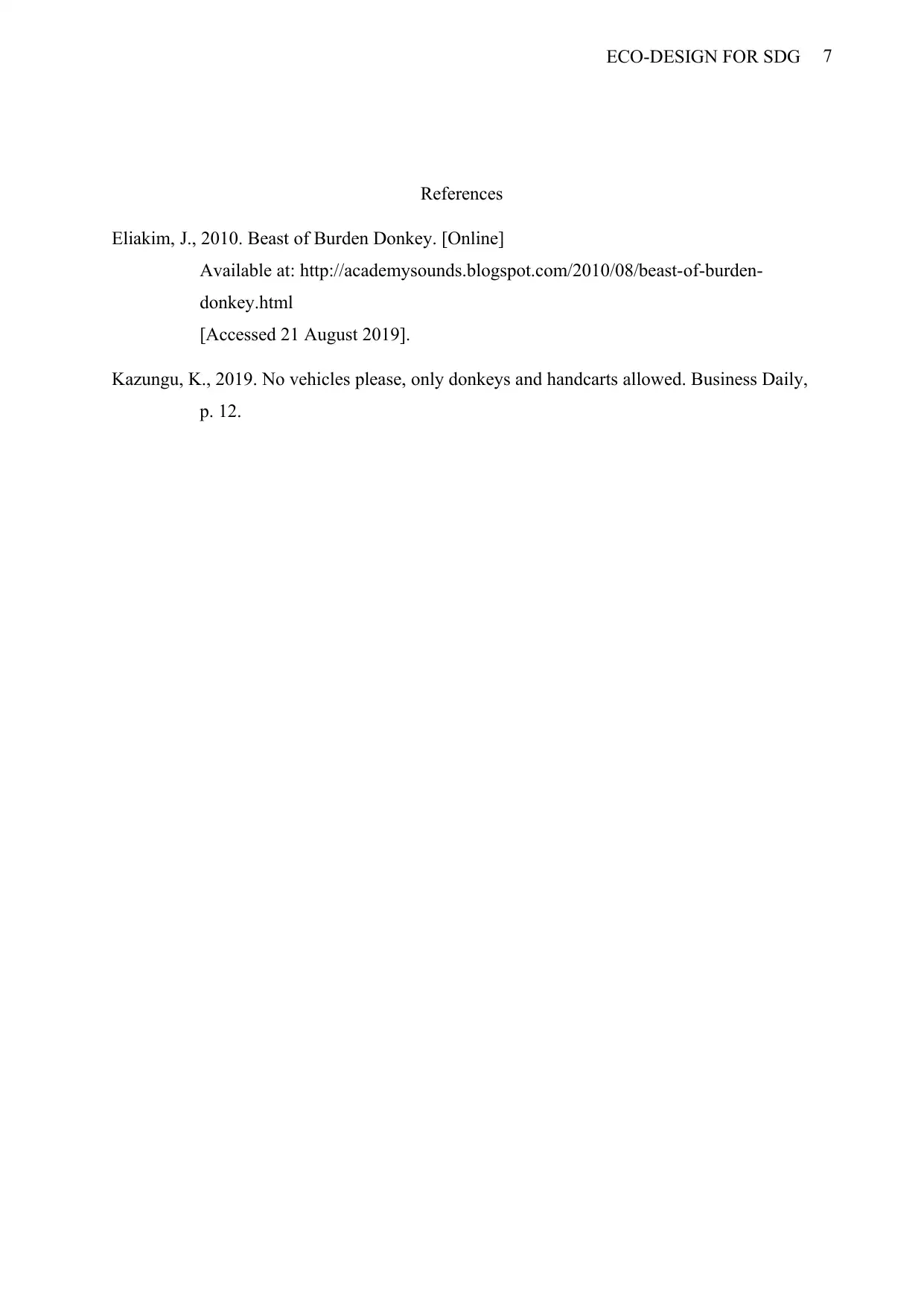
7ECO-DESIGN FOR SDG
References
Eliakim, J., 2010. Beast of Burden Donkey. [Online]
Available at: http://academysounds.blogspot.com/2010/08/beast-of-burden-
donkey.html
[Accessed 21 August 2019].
Kazungu, K., 2019. No vehicles please, only donkeys and handcarts allowed. Business Daily,
p. 12.
References
Eliakim, J., 2010. Beast of Burden Donkey. [Online]
Available at: http://academysounds.blogspot.com/2010/08/beast-of-burden-
donkey.html
[Accessed 21 August 2019].
Kazungu, K., 2019. No vehicles please, only donkeys and handcarts allowed. Business Daily,
p. 12.
1 out of 7
Related Documents
Your All-in-One AI-Powered Toolkit for Academic Success.
+13062052269
info@desklib.com
Available 24*7 on WhatsApp / Email
![[object Object]](/_next/static/media/star-bottom.7253800d.svg)
Unlock your academic potential
Copyright © 2020–2025 A2Z Services. All Rights Reserved. Developed and managed by ZUCOL.




